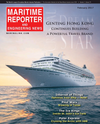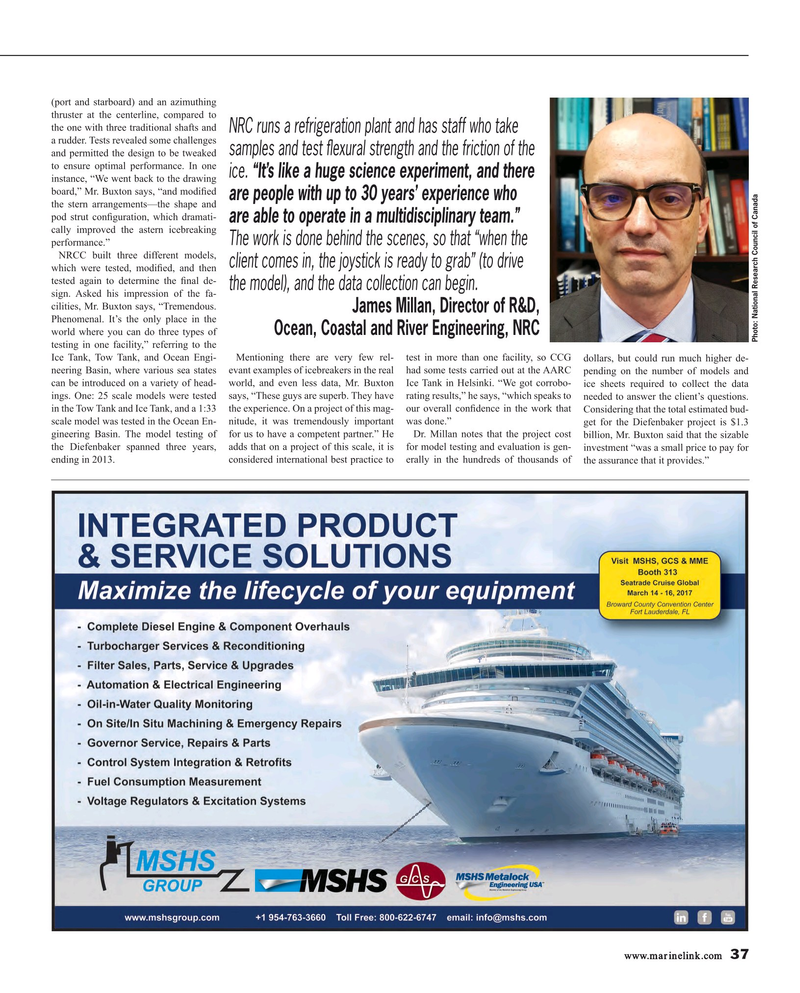
Page 37: of Maritime Reporter Magazine (February 2017)
The Cruise Industry Edition
Read this page in Pdf, Flash or Html5 edition of February 2017 Maritime Reporter Magazine
(port and starboard) and an azimuthing thruster at the centerline, compared to the one with three traditional shafts and
NRC runs a refrigeration plant and has staff who take a rudder. Tests revealed some challenges samples and test ? exural strength and the friction of the and permitted the design to be tweaked to ensure optimal performance. In one ice. “It’s like a huge science experiment, and there instance, “We went back to the drawing board,” Mr. Buxton says, “and modi? ed are people with up to 30 years’ experience who the stern arrangements—the shape and pod strut con? guration, which dramati- are able to operate in a multidisciplinary team.” cally improved the astern icebreaking
The work is done behind the scenes, so that “when the performance.”
NRCC built three different models, client comes in, the joystick is ready to grab” (to drive which were tested, modi? ed, and then tested again to determine the ? nal de- the model), and the data collection can begin.
sign. Asked his impression of the fa- cilities, Mr. Buxton says, “Tremendous.
James Millan, Director of R&D,
Phenomenal. It’s the only place in the
Ocean, Coastal and River Engineering, NRC world where you can do three types of
Photo: National Research Council of Canada testing in one facility,” referring to the
Ice Tank, Tow Tank, and Ocean Engi- Mentioning there are very few rel- test in more than one facility, so CCG dollars, but could run much higher de- neering Basin, where various sea states evant examples of icebreakers in the real had some tests carried out at the AARC pending on the number of models and can be introduced on a variety of head- world, and even less data, Mr. Buxton Ice Tank in Helsinki. “We got corrobo- ice sheets required to collect the data ings. One: 25 scale models were tested says, “These guys are superb. They have rating results,” he says, “which speaks to needed to answer the client’s questions. in the Tow Tank and Ice Tank, and a 1:33 the experience. On a project of this mag- our overall con? dence in the work that Considering that the total estimated bud- scale model was tested in the Ocean En- nitude, it was tremendously important was done.” get for the Diefenbaker project is $1.3 gineering Basin. The model testing of for us to have a competent partner.” He Dr. Millan notes that the project cost billion, Mr. Buxton said that the sizable the Diefenbaker spanned three years, adds that on a project of this scale, it is for model testing and evaluation is gen- investment “was a small price to pay for ending in 2013. considered international best practice to erally in the hundreds of thousands of the assurance that it provides.” www.marinelink.com 37
MR #2 (34-41).indd 37 MR #2 (34-41).indd 37 2/6/2017 11:19:20 AM2/6/2017 11:19:20 AM

 36
36

 38
38
